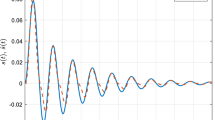Abstract
A unified treatment of stable behavior and fault tolerance of finite automata based on the concepts of tolerance spaces and fuzrelations is given. In particular, attractor sets of automata states, approximate fixed points, and almost periodicity of state transitions of finite automata are investigated.
Similar content being viewed by others
References
R. E. Kalman, P. L. Falb, and M. A. Arbib,Topics in Mathematical System Theory (McGraw-Hill, New York, 1969).
W. Brauer, “Zu den Grundlagen einer Theorie topologischer sequentieller Systeme und Automaten,”Gesellschaft für Mathematik und Datenverarbeitung, Bonn 1970 (31).
T.G. Windeknecht,General Dynamical Processes, A Mathematical Introduction (Academic, New York, 1971).
H. Poincaré,The Value of Science (1913; reprinted by Dover, New York, 1958), p. 37.
J. von Neumann, in A. W. Burks, ed.,Theory of Selfreproducing Automata (U. of Illinois Press, Urbana, Illinois) 1966.
E. C. Zeeman, in K. Fort, ed.,Topology of 3-Manifolds (Prentice-Hall, Englewood Cliffs, New Jersey, 1961), pp. 240–256.
T. Poston, “Fuzzy geometry,” Doct. Thesis, U. of Warwick (1971).
M. A. Arbib, “Tolerance automata,”Kybernetika 3:223–233 (1967).
W. De Backer and L. Verbeek, Study of analog, digital and hybrid computers using automata theory,ICC Bulletin 5:215–244 (1966).
R. T. Yeh, “On the relational homomorphisms of automata,”Inf. Control 13:140–155 (1968).
A, Gill and J. R. Flexer, “Periodic decomposition of sequential machines,”J. Assoc. Comput. Mach. 14:666–676 (1967).
M. A. Harrison, “On the error correcting capacity of finite automata,”Inf. Control 8:430–450 (1965).
M. Dal Cin, “Modification tolerance of fuzzy-state automata,” this issue, following paper.
J. Hartmanis and R. E. Stearns, “A study of feedback and errors in sequential machines,”IEEE Trans. Electron. Comput. EC-12:223–232 (1963).
P. S. Dauber, “An analysis of errors in finite automata,”Inf. Control 8:295–303 (1965).
T. Takaoka,in Proc. 3rd. Hawaii Int. Conf. Syst. Sci. (1970), pp. 76–79.
S. Winograd, “Input error limiting automata,”J. Assoc. Comput. Mach. 11:338–351 (1964).
Author information
Authors and Affiliations
Rights and permissions
About this article
Cite this article
Dal Cin, M. Fuzzy-state automata: Their stability and fault tolerance. International Journal of Computer and Information Sciences 4, 63–80 (1975). https://doi.org/10.1007/BF00976219
Received:
Revised:
Issue Date:
DOI: https://doi.org/10.1007/BF00976219




